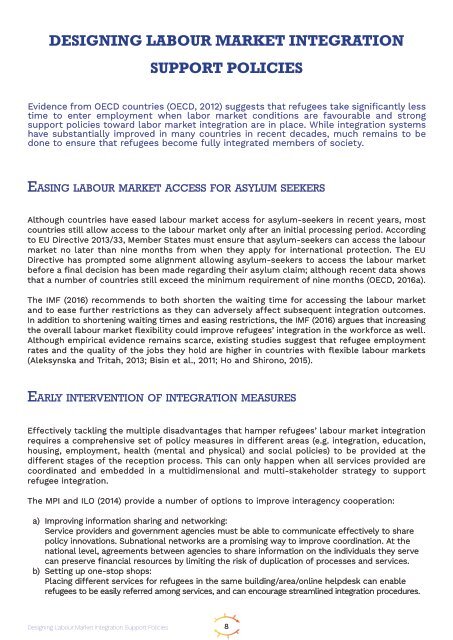Guidelines S2W 2018
Create successful ePaper yourself
Turn your PDF publications into a flip-book with our unique Google optimized e-Paper software.
DESIGNING LABOUR MARKET INTEGRATION<br />
SUPPORT POLICIES<br />
Evidence from OECD countries (OECD, 2012) suggests that refugees take significantly less<br />
time to enter employment when labor market conditions are favourable and strong<br />
support policies toward labor market integration are in place. While integration systems<br />
have substantially improved in many countries in recent decades, much remains to be<br />
done to ensure that refugees become fully integrated members of society.<br />
Easing labour market access for asylum seekers<br />
Although countries have eased labour market access for asylum-seekers in recent years, most<br />
countries still allow access to the labour market only after an initial processing period. According<br />
to EU Directive 2013/33, Member States must ensure that asylum-seekers can access the labour<br />
market no later than nine months from when they apply for international protection. The EU<br />
Directive has prompted some alignment allowing asylum-seekers to access the labour market<br />
before a final decision has been made regarding their asylum claim; although recent data shows<br />
that a number of countries still exceed the minimum requirement of nine months (OECD, 2016a).<br />
The IMF (2016) recommends to both shorten the waiting time for accessing the labour market<br />
and to ease further restrictions as they can adversely affect subsequent integration outcomes.<br />
In addition to shortening waiting times and easing restrictions, the IMF (2016) argues that increasing<br />
the overall labour market flexibility could improve refugees’ integration in the workforce as well.<br />
Although empirical evidence remains scarce, existing studies suggest that refugee employment<br />
rates and the quality of the jobs they hold are higher in countries with flexible labour markets<br />
(Aleksynska and Tritah, 2013; Bisin et al., 2011; Ho and Shirono, 2015).<br />
Early intervention of integration measures<br />
Effectively tackling the multiple disadvantages that hamper refugees’ labour market integration<br />
requires a comprehensive set of policy measures in different areas (e.g. integration, education,<br />
housing, employment, health (mental and physical) and social policies) to be provided at the<br />
different stages of the reception process. This can only happen when all services provided are<br />
coordinated and embedded in a multidimensional and multi-stakeholder strategy to support<br />
refugee integration.<br />
The MPI and ILO (2014) provide a number of options to improve interagency cooperation:<br />
a) Improving information sharing and networking:<br />
Service providers and government agencies must be able to communicate effectively to share<br />
policy innovations. Subnational networks are a promising way to improve coordination. At the<br />
national level, agreements between agencies to share information on the individuals they serve<br />
can preserve financial resources by limiting the risk of duplication of processes and services.<br />
b) Setting up one-stop shops:<br />
Placing different services for refugees in the same building/area/online helpdesk can enable<br />
refugees to be easily referred among services, and can encourage streamlined integration procedures.<br />
Designing Labour Market Integration Support Policies<br />
8



